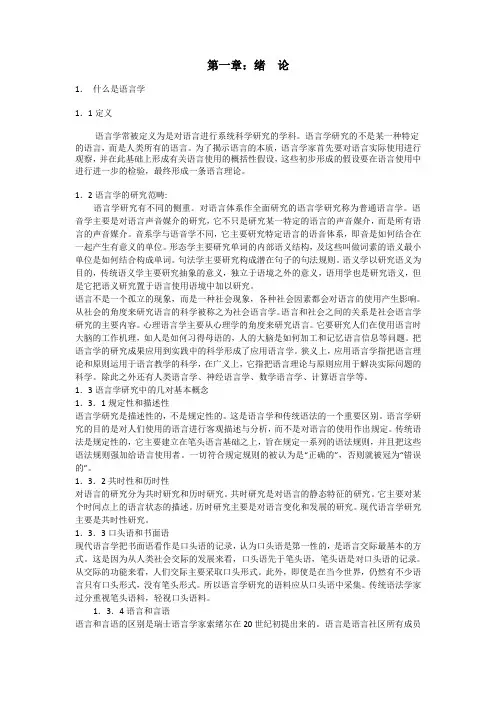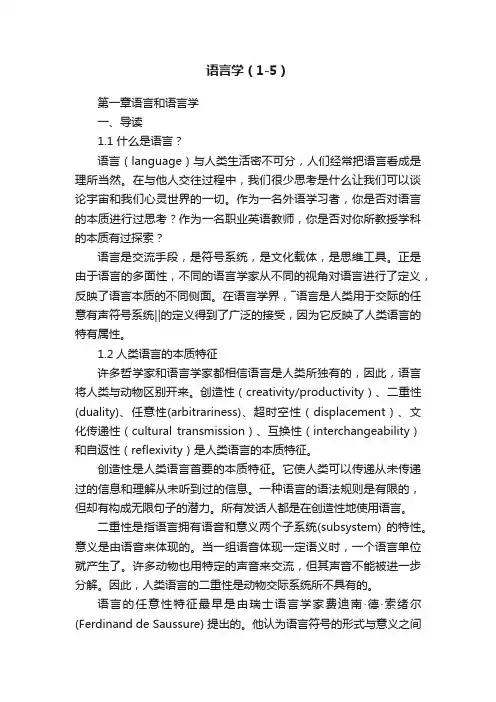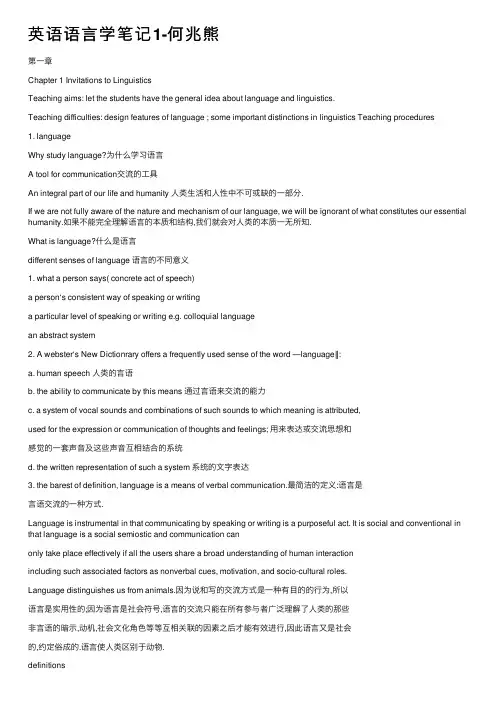英语语言学第一章第二章
英语语言学第一章、第二章

第一章:绪论1.什么是语言学1.1定义语言学常被定义为是对语言进行系统科学研究的学科。
语言学研究的不是某一种特定的语言,而是人类所有的语言。
为了揭示语言的本质,语言学家首先要对语言实际使用进行观察,并在此基础上形成有关语言使用的概括性假设,这些初步形成的假设要在语言使用中进行进一步的检验,最终形成一条语言理论。
1.2语言学的研究范畴:语言学研究有不同的侧重。
对语言体系作全面研究的语言学研究称为普通语言学。
语音学主要是对语言声音媒介的研究,它不只是研究某一特定的语言的声音媒介,而是所有语言的声音媒介。
音系学与语音学不同,它主要研究特定语言的语音体系,即音是如何结合在一起产生有意义的单位。
形态学主要研究单词的内部语义结构,及这些叫做词素的语义最小单位是如何结合构成单词。
句法学主要研究构成潜在句子的句法规则。
语义学以研究语义为目的,传统语义学主要研究抽象的意义,独立于语境之外的意义,语用学也是研究语义,但是它把语义研究置于语言使用语境中加以研究。
语言不是一个孤立的现象,而是一种社会现象,各种社会因素都会对语言的使用产生影响。
从社会的角度来研究语言的科学被称之为社会语言学。
语言和社会之间的关系是社会语言学研究的主要内容。
心理语言学主要从心理学的角度来研究语言。
它要研究人们在使用语言时大脑的工作机理,如人是如何习得母语的,人的大脑是如何加工和记忆语言信息等问题。
把语言学的研究成果应用到实践中的科学形成了应用语言学。
狭义上,应用语言学指把语言理论和原则运用于语言教学的科学,在广义上,它指把语言理论与原则应用于解决实际问题的科学。
除此之外还有人类语言学、神经语言学、数学语言学、计算语言学等。
1.3语言学研究中的几对基本概念1.3.1规定性和描述性语言学研究是描述性的,不是规定性的。
这是语言学和传统语法的一个重要区别。
语言学研究的目的是对人们使用的语言进行客观描述与分析,而不是对语言的使用作出规定。
传统语法是规定性的,它主要建立在笔头语言基础之上,旨在规定一系列的语法规则,并且把这些语法规则强加给语言使用者。
语言学第一章

语言学第一章Chapter 1 Invitation to linguistics1.1 Why study language?1. Language is very essential to human beings.2. In language there are many things we should know.3. For further understanding, we need to study language scientifically.1.2 What is language?Language is a means of verbal communication. It is a system of arbitrary vocal symbols used for human communication.1.3 Design features of languageThe features that define our human languages can be called design features which can distinguish human language from any animal system of communication.1.3.1 ArbitrarinessArbitrariness refers to the fact that the forms of linguistic signs bear no natural relationship to their meanings.1.3.2 DualityDuality refers to the property of having two levels of structures, such that units of the primary level are composed of elements of the secondary level and each of the two levels has its own principles of organization.1.3.3 CreativityCreativity means that language is resourceful because of its duality and its recursiveness.Recursiveness refers to the rule which can be applied repeatedly without any definite limit. The recursive nature of language provides a theoretical basis for the possibility of creating endless sentences.1.3.4 DisplacementDisplacement means that human languages enable their users to symbolize objects, events and concepts which are not present (in time and space) at the moment of conversation.1.4 Origin of language1. The bow-wow theoryIn primitive times people imitated the sounds of the animal calls in the wild environment they lived and speech developed from that.2. The pooh-pooh theoryIn the hard life of our primitive ancestors, they utter instinctive sounds of pains, anger and joy which gradually developed into language.3. The “yo-he-ho” theoryAs primitive people worked together, they produced some rhythmic grunts which gradually developed into chants and then into language.1.5 Functions of languageJacobson——language has six functions:1. Referential指称功能: to convey message and information;2. Poetic: to indulge in language for its own sake;3. Emotive: to express attitudes, feelings and emotions;4. Conative意动功能: to persuade and influence others through commands and entreaties;5. Phatic寒暄功能: to establish communion with others;6. Metalingual元语功能: to clear up intentions, words and meanings.Halliday ——that language has three metafunctions:1. Ideational function: to convey new information, to communicate a content that is unknown to thehearer;2. Interpersonal function: embodying all use of language to express social and personal relationships;3. Textual function: referring to the fact that language has mechanisms to make any stretch of spokenand written discourse into a coherent and unified text and make a living passage different from a random list of sentences.Hu Zhuanglin——language has at least seven functions:1.5.1 InformativeThe informative function means language is the instrument of thought and people often use it to communicate new information.1.5.2 Interpersonal functionThe interpersonal function means people can use language to establish and maintain their status in a society.1.5.3 Performative施为功能The performative function of language is primarily to change the social status of persons, as in marriage ceremonies, the sentencing of criminals, the blessing of children, the naming of a ship at a launching ceremony, and the cursing of enemies.1.5.4 Emotive functionThe emotive function is one of the most powerful uses of language because it is so crucial in changing the emotional status of an audience for or against someone or something.1.5.5 Phatic communionThe phatic communion means people always use some small, seemingly meaningless expressions such as Good morning, God bless you, Nice day,etc., to maintain a comfortable relationship between people without any factual content.1.5.6 Recreational functionThe recreational function means people use language for the sheer joy of using it, suc h as a baby’s babbling or a chanter’s chanting.1.5.7 Metalingual functionThe metalingual function means people can use language to talk about itself. E.g. I can use the word “book” to talk about a book, and I can also use the expression “the word book” t o talk about the sign “b-o-o-k” itself.1.6 What is linguistics?Linguistics is the scientific study of language. It studies not just one language of any one community, but the language of all human beings.1.7 Main branches of linguistics1.7.1 PhoneticsPhonetics is the study of speech sounds, it includes three main areas: articulatory phonetics, acoustic phonetics, and auditory phonetics.1.7.2 PhonologyPhonology studies the rules governing the structure, distribution, and sequencing of speech sounds and the shape of syllables.1.7.3 MorphologyMorphology studies the minimal units of meaning –morphemes and word-formation processes.1.7.4 SyntaxSyntax refers to the rules governing the way words are combined to form sentences in a language, or simply, the study of the formation of sentences.1.7.5 SemanticsSemantics examines how meaning is encoded in a language.1.7.6 PragmaticsPragmatics is the study of meaning in context.1.8 MacrolinguisticsMacrolinguistics is the study of language in all aspects, distinct from microlinguistics, which dealtsolely with the formal aspect of language system.1.8.1 Psycholinguistics心理语言学Psycholinguistics investigates the interrelation of language and mind, in processing and producing utterances (and in language acquisition for example).1.8.2 Sociolinguistics社会语言学Sociolinguistics is the study of the characteristics of language varieties1, the characteristics of their functions2, and the characteristics of their speakers3. (123相互作用构成一个speech community 语言社团)1.8.3 Anthropological linguistics人类语言学Anthropological linguistics studies the history and structure of formerly unwritten language, the emergence of language and the divergence of languages.1.8.4 Computational linguistics计算语言学Computational linguistics is an interdisciplinary field which centers around the use of computers to process or produce human language.1.9 Important distinctions in linguistics1.9.1 Descriptive描写vs. Prescriptive规定A linguistic study is descriptive if it describes and analyses the facts observed.It is prescriptive if it tries to lay down rules for the “correct” use of language.1.9.2 Synchronic共时vs. Diachronic历时The description of a language at some point in time is a synchronic study.The description of a language as it changes through the time is a diachronic study.The distinction between synchronic and dischronic studies is only theoretically clear.原因:①Languages are in a constant state of changing.②The language of any speech community is never uniform.③When a language changes, one set o f features are not suddenly replaced by another set of features.1.9.3 Langue 语言& parole言语Saussure distinguished the linguistic competence of the speaker and the actual phenomena or data of linguistics as langue and parole.Langue refers to the abstract linguistic system shared by all the members of a speech community.Parole refers to the actualized language, or realization of langue.区别:①Langue is abstract but parole is specific to the situation in which it occurs.②Langue is not actually spoken by anyone; parole is alwaysa naturally occurring event.③Langue is relatively stable and systematic; parole is subject to personal and situational constraints.1.9.4 Competence and performanceAccording to Chomsky, a language user’s underlying knowledge about the system of rules is called the linguistic competence, and the actual use of language in concretesituations is called performance.Competence is the ideal language user`s knowledge of the rules of his language.Performance is the actual realization of this knowledge in utterances.。
语言学(1-5)

语言学(1-5)第一章语言和语言学一、导读1.1 什么是语言?语言(language)与人类生活密不可分,人们经常把语言看成是理所当然。
在与他人交往过程中,我们很少思考是什么让我们可以谈论宇宙和我们心灵世界的一切。
作为一名外语学习者,你是否对语言的本质进行过思考?作为一名职业英语教师,你是否对你所教授学科的本质有过探索?语言是交流手段,是符号系统,是文化载体,是思维工具。
正是由于语言的多面性,不同的语言学家从不同的视角对语言进行了定义,反映了语言本质的不同侧面。
在语言学界,―语言是人类用于交际的任意有声符号系统‖的定义得到了广泛的接受,因为它反映了人类语言的特有属性。
1.2人类语言的本质特征许多哲学家和语言学家都相信语言是人类所独有的,因此,语言将人类与动物区别开来。
创造性(creativity/productivity)、二重性(duality)、任意性(arbitrariness)、超时空性(displacement)、文化传递性(cultural transmission)、互换性(interchangeability)和自返性(reflexivity)是人类语言的本质特征。
创造性是人类语言首要的本质特征。
它使人类可以传递从未传递过的信息和理解从未听到过的信息。
一种语言的语法规则是有限的,但却有构成无限句子的潜力。
所有发话人都是在创造性地使用语言。
二重性是指语言拥有语音和意义两个子系统(subsystem) 的特性。
意义是由语音来体现的。
当一组语音体现一定语义时,一个语言单位就产生了。
许多动物也用特定的声音来交流,但其声音不能被进一步分解。
因此,人类语言的二重性是动物交际系统所不具有的。
语言的任意性特征最早是由瑞士语言学家费迪南·德·索绪尔(Ferdinand de Saussure) 提出的。
他认为语言符号的形式与意义之间没有自然的联系。
在大部分语言中都存在拟声词,他们的声音和意义之间似乎有一定的关系。
英语语言学笔记1-何兆熊

英语语⾔学笔记1-何兆熊第⼀章Chapter 1 Invitations to LinguisticsTeaching aims: let the students have the general idea about language and linguistics.Teaching difficulties: design features of language ; some important distinctions in linguistics Teaching procedures1. languageWhy study language?为什么学习语⾔A tool for communication交流的⼯具An integral part of our life and humanity ⼈类⽣活和⼈性中不可或缺的⼀部分.If we are not fully aware of the nature and mechanism of our language, we will be ignorant of what constitutes our essential humanity.如果不能完全理解语⾔的本质和结构,我们就会对⼈类的本质⼀⽆所知.What is language?什么是语⾔different senses of language 语⾔的不同意义1. what a person says( concrete act of speech)a person‘s consistent way of speaking or writinga particular level of speaking or writing e.g. colloquial languagean abstract system2. A webster‘s New Dictionrary offers a frequently used sense of the word ―language‖:a. human speech ⼈类的⾔语b. the ability to communicate by this means 通过⾔语来交流的能⼒c. a system of vocal sounds and combinations of such sounds to which meaning is attributed,used for the expression or communication of thoughts and feelings; ⽤来表达或交流思想和感觉的⼀套声⾳及这些声⾳互相结合的系统d. the written representation of such a system 系统的⽂字表达3. the barest of definition, language is a means of verbal communication.最简洁的定义:语⾔是⾔语交流的⼀种⽅式.Language is instrumental in that communicating by speaking or writing is a purposeful act. It is social and conventional in that language is a social semiostic and communication canonly take place effectively if all the users share a broad understanding of human interactionincluding such associated factors as nonverbal cues, motivation, and socio-cultural roles.Language distinguishes us from animals.因为说和写的交流⽅式是⼀种有⽬的的⾏为,所以语⾔是实⽤性的;因为语⾔是社会符号,语⾔的交流只能在所有参与者⼴泛理解了⼈类的那些⾮⾔语的暗⽰,动机,社会⽂化⾓⾊等等互相关联的因素之后才能有效进⾏,因此语⾔⼜是社会的,约定俗成的.语⾔使⼈类区别于动物.definitionsLanguage is a system of arbitrary vocal symbols used for human communication.What is communication?A process in which information is transmitted from a source (sender or speaker) to a goal (receiveror listener).A system----since elements in it are arranged according to certain rules systematically, rather thanrandomly. They cannot be arranged at will. e.g. He the table cleaned. (×) bkli (×) Why do we say language is arbitrary? Arbitrary----there is no intrinsic (logic) connection between a linguistic form and its meaning, between the sounds that people use and the objects to which these sounds refer. Thisexplains and is explained by the fact that different language have different words for thesame object, it is good illustration of the arbitrary nature of language . it is only our tacitagreement of utterance and concept at work and not any innate relationship bound upin the utterance. A typical example to illustrate the arbitrary of language is a famousquotation from shakepeare‘s play:‖ Romeo and Juliet: A rose by any other name wouldsmell as sweet.⼀朵玫瑰不管它叫什么名字,闻起来都是⼀样⾹的.Symbols----words are just the symbols associated with objects, actions, and ideas by nothing but convention. Namely, people use the sounds or voval forms to symbolize what they wishto refer to.Vocal-------- the primary medium for all languages is sound, no matter how well developed their writing systems are. Writing systems came much later than the spoken forms. The factthat small children learn and can only learn to speak and listen before they write or readalso indicates that language is primarily vocal, rather than written.Writing systems came into being much later than the spoken forms.People with little or no literacy can also be competent language users.Human ----language is human-specific.Human beings have different kinds of brains and vocal capacity.―Language Acquisition Device‖(LAD)⼆.What characteristics of langauge do you think should be included in a good ,comprenhensive definition of language? Language is a rule-governed system; langauge is basically vocal; langauge is arbitrary ; langague is used for human communication.1.3 Design features of language 语⾔的结构特征Design features------ refers to the defining properties of human language that distinguish it from any animal system of communication. They are arbitrariness, duality, creativity/ productivity, displacement, clutural transmission and interchangeability.Design features----- are features that define our human languages,such asarbitrariness,duality,creativity,displacement,cultural transmission,etc.(指决定了⼈类语⾔性质的特征.例如任意性,⼆重性,创造性,移位性,⽂化转移性等.)The American linguist Charles Hockett specified twelve design features.What is arbitrariness?任意性a. arbitrariness【'ɑ?b?tr?r?n?s】----arbitrariness(任意性): one design feature of humanlanguage,which refers to the fact that the forms of linguistic signs bear no naturalrelationship to their meaning.(⼈类语⾔的本质特征之⼀,指语⾔符号的形式与意义之间没有⾃然的联系.)It was discussed by Saussure first.The link between them is a matter of convention.E.g. ―house‖ uchi (Japanese)Mansion (French)房⼦(Chinese)(1) arbitrary between the sound of a morpheme and its meaning语⾔的⾳和义之间的任意性a. By ―arbitrary‖, we mean there is no logical connection between meanings and sounds. 语⾔的意义和语⾳之间没有逻辑关系。
新编简明英语语言学 第一章

What is linguistics?
---It is a scientific study because it is based on the systemetic investigation of linguistic data, conducted with reference to some general theory of language structure.
> Modern linguistics regards the spoken language as primary, not the written. Traditional grammarians tended to emphasize the importance of the written word.
---Hall, 1968
语言是“人类利用约定俗成的任意性视听符号借以相互交流和影响的习惯体 系”。
---霍尔 , 1968
What is language?
From now on I will consider language to be a set (finite or infinite) of sentences, each finite in length and constructed out of a finite set of elements.
synchronic and diachronic
>The description of a language at some point of time in history is a synchronic study.
对历史上某一时间点的语言状况 所作的研究是共时研究
>The description of a language as it changes through time is a diachronic study.
语言学英语第一章

促进
教Leabharlann 学影响1.2.4 母语,第二语言和外语的学习环境
* 以英语为母语的十个国家: 美 国 加拿大 圭亚那 联合王国 澳大利亚 爱 尔 兰 巴巴多斯 新 西 兰 特立尼达
牙买加
* 英语作为第二语言的作用(ESL): 官方语言,是法律界,政府部门,学校,商界和大众媒介 的主要语言。
主要应用国家:南非
1 质的准则 (Maxim of quality – Be truthful)
2 量的准则 (Maxim of quantity – Meet the need ) 3 相关准则(Maxim of relation - Relevance) 4 方式准则(Maxim of manners – Be clear)
Thank you!
图 示 理 论
图式是在以往经验的旧知识与新信息相互联系的基础上,通过 “同化”与“顺应”而形成的,是以往经验的积极组织。
1.3.4 英语教学法和哲学:
* 马列主义的哲学体系有助于我们在研究英语教与学时客
观,准确,全面辩证地研究教与学的现象和问题,探讨 教与学之间的关系,摸索教和学的规律。 * 哲学家对语言的研究成果也作用于英语教学法。 例 Grice的会话含意理论中的“合作准则”:
第一章 导
言
1.1 英语教学法概述
* 研究对象:英语教学 (How to learn + How to teach) * 研究目的:探讨英语教学的内部规律,从而为更好更快更有效 地教授和学习英语提出有关的理论和方法。 * 研究方法:实验法(观察+归纳) Suppose → Test (Control) → Conclude
和对这些事件施加作用; * 学习是相对持久的,但也会遗忘; * 学习涉及某种形式的训练,或许是强化训练 * 学习是行为的变化
英语语言学概论
《英语语言学概论》重、难点提示第一章语言的性质语言的定义:语言的基本特征(任意性、二重性、多产性、移位、文化传递和互换性);语言的功能(寒暄、指令、提供信息、询问、表达主观感情、唤起对方的感情和言语行为);语言的起源(神授说,人造说,进化说)等。
第二章语言学语言学定义;研究语言的四大原则(穷尽、一致、简洁、客观);语言学的基本概念(口语与书面语、共时与历时、语言与言学、语言能力与言行运用、语言潜势与语言行为);普通语言学的分支(语音、音位、语法、句法、语义);;语言学的应用(语言学与语言教学、语言与社会、语言与文字、语言与心理学、人类语言学、神经语言学、数理语言学、计算语言学)等。
第三章语音学发音器官的英文名称;英语辅音的发音部位和发音方法;语音学的定义;发音语音学;听觉语音学;声学语音学;元音及辅音的分类;严式与宽式标音等。
第四章音位学音位理论;最小对立体;自由变异;互补分布;语音的相似性;区别性特征;超语段音位学;音节;重音(词重音、句子重音、音高和语调)等。
第五章词法学词法的定义;曲折词与派生词;构词法(合成与派生);词素的定义;词素变体;自由词素;粘着词素(词根,词缀和词干)等。
第六章词汇学词的定义;语法词与词汇词;变词与不变词;封闭词与开放词;词的辨认;习语与搭配。
第七章句法句法的定义;句法关系;结构;成分;直接成分分析法;并列结构与从属结构;句子成分;范畴(性,数,格);一致;短语,从句,句子扩展等。
第八章语义学语义的定义;语义的有关理论;意义种类(传统、功能、语用);里奇的语义分类;词汇意义关系(同义、反义、下义);句子语义关系。
第九章语言变化语言的发展变化(词汇变化、语音书写文字、语法变化、语义变化);第十章语言、思维与文化语言与文化的定义;萨丕尔-沃夫假说;语言与思维的关系;语言与文化的关系;中西文化的异同。
第十一章语用学语用学的定义;语义学与语用学的区别;语境与意义;言语行为理论(言内行为、言外行为和言后行为);合作原则。
chapter 1(1) 英语语言学,第一章
养的。”
记者将他的话公诸于
众,华盛顿的议员们一定要马
克 ·吐 温 在 报 上 登 个 启 事 , 赔 礼
道 歉 。 于 是 , 马 克 ·吐 温 写 了 这
样一张启事:“以前鄙人在酒席上发言,
说某些国会议员是狗娘养的,我再三考
虑,觉得此言不妥,而且不合事实,特登
报声明,把我的话修改成:
某些国会议员不是狗娘养的。
❖ ② language is arbitrary and symbolic. There is no intrinsic connection between the word and the thing. It is symbolic in that linguistic elements are symbols or signs, not objects, actions or things, but they are associated with objects or actions.
Definition of language: Language is a system of arbitrary vocal symbols used for human communication.
① language is a system: elements in language are arranged according to rules. The elements can not be produced and combined at random. If so, language can not be used and learned consistently.
❖ A Sketch of the Course
❖ Chapter 1: general introductions to language and linguistics
英语语言学第一章
• Modern linguistics:
speech first, then writing
Exercise:
• 1.What is the differences between langue and parole? • 2. What is the differences between competence and performance? 3. What is the descriptive study of linguistics?
• Anthropological linguistics • Applied linguistics Recent Developments Corpus linguistics ●Cognitive linguistics
●
2Some Important Concepts
prescriptive & descriptive P: lay down rules D: describe what people actually say
Syntagmatic & paradigmatic • Syntagmatic:
horizontal, linear sequences
• Paradigmatic:
vertical, substitution
speech &writing • Traditional grammar:
writing superior
Language can describe real or imagined matters in the past, present, or future or in far-away places.
Productivity Language speakers can produce and understand utterances that they have never heard before.
语言学概论第一章要点英语
语言学概论第一章要点(2011-08-26 10:30:48)第一章Introduction1.Linguistics定义It is generally defined as the scientific study of language.Nowadays, the generally accepted definition of language is that language is a system of arbitrary vocal symbols used for human communication.2.The scope of linguistics语言学的主要分支是什么。
每个分支的研究对象是什么?1.General linguistics, which is the study of language as a whole and which deals with the basic concepts, theories, descriptions, models and methods applicable in any linguistic study①Phonetics,which studies the sounds that are used in linguistic communication②Phonology,which studies how sounds are put together and used in communication③Morphology,which studies the way in which morphemes are arranged to form words④Syntax,which studies how morphemes and words are combined to form sentences⑤Semantics, which is the study of meaning in language.⑥Pragmatics,which is the study of meaning not in isolation, but in context of use⑦Sociolinguistics,which is the study of language with reference to society⑧Psycholinguistics, which is the study of language with reference to the workings of mind.⑨Applied linguistics,which is concerned about the application of linguistic findings in linguistic studies; in a narrow sense, applied linguistics refers to the application of linguistic principles and theories to language teaching and learning, especially the teaching of foreign and second languages.Other related branches are anthropological linguistics, neurological linguistics, mathematical linguistics, and computational linguistics.3.现代语言学与传统语法有什么区别?Traditional grammar is prescriptive; it is based on "high "(religious, literary) written language . It sets models for language users to follow. But Modern linguistics is descriptive; its investigations are based on authentic, and mainly spoken language data. It is supposed to be scientific and objective and the task of linguists is supposed to describe the language people actually use, whether it is "correct" or not.4.Some important distinction in linguistics语言学五对基本概念1、descriptive(描述性) :A linguistic study describes and analyzes the language people actually use.2、prescriptive(规定性): It aims to lay down rules for “correct” behaviors. i.e. what they should say and what they should not to say.1、synchronic(共时语言学): It refers to the study of variation in language in different places and among different groups at a given point in time.2、diachronic(历时语言学): Studies language change over various periods of time and at various historical stages.什么叫共时研究Synchronic study;?什么叫历时研究diachronic study?The description of a language at some point in time is a Synchronic study; the description of a language as it changes through time is a diachronic study. A synchronic study of language describes alanguage as it is at some particular point in rime, while a diachronic study of language is a historical study; it studies the historical development of language over a period of time.1、speech and writing are the two media of communication. Modern linguistics regards the spoken language as primary, not the written.1、langue(语言): refers to abstract linguistic system shared by all the members of the speech community. It is the set of conventions and rules which language users all have to abide by. Such as: In English sentence must have subject and predicate.2、parole(言语):refers to the realization of langue in actual use. It is concrete use of the conventions and the application of the rules.1、competence(语言能力):As the ideal user’s knowledge of the rules of his language2、performance(语言应用):the actual realization of his knowledge in linguistic communication.5、What is language?Language is a system of arbitrary vocal symbols used for human communication.Language is a system i.e. elements of language are combined according to rules.Language is arbitrary .because the fact that different languages have different words for the some object.Language is vocal because the primary medium is sound for all languages.Language is symbols.The term “human” in the definition is meant to specify that language is human specific.6、人类语言的甄别性特征design features是什么?(五个)Design features refer to the defining properties of human language that distinguish it from any animal system of communication.The American Charles Hockett specified 12 design features, 5 of which will be discussed here.Arbitrariness:任意性there is no logical connection between meanings and sounds .A good example is the fact that different sounds are used to refer to the same object in different language, but it is not entirely arbitrary.Productivity:创造性language make possible the construction and interpretation of new signals by it users. Productivity is unique to human language.Duality(二重性):Language is a system, which consists of two sets of structures, or two levels at the lower or the basic level there is a structure of sounds, which are meaningless. But the sounds of language can be grouped and regrouped into a large number of units of meaning such as morphemes and words.Displacement:移位性Language can be used to refer to things which are present or not present, real or imagined matters in past, present or future. or in far-away place. In other words, language can be used to refer to context removed from the immediate situations of speakers.Cultural transmission(文化传递性)While we are born with the ability to acquire language, the details of any language are not genetically transmitted, but instead have to be taught and learned anew.5. Chomsky的语言能力和语言使用各指什么?American linguist N. Chomsky in the late 1950’s proposed the distinction between competence and performance. Chomsky defines competence as the ideal user’s knowledge of the rules of his language. This internalized set of rules enables the language user to produce and understand an infinitely large number of sentences and recognize sentences that are ungrammatical and ambiguous. According to Chomsky, performance is the actual realization of this knowledge in linguistic communication. Although the speaker’s knowledge of his mother tongue is perfect, his performances may have mistakes because of social and psychological factors such as stress, embarrassment, etc.. Chomsky believes that what linguists should study is the competence, which is systematic, not the performance, which is too haphazard.7、Saussure是如何区分语言和言语的?The distinction between langue, and parole was made by the famous Swiss linguist Ferdinand de Saussure early this century. Langue and parole are French words. Langue refers to the abstract linguistic system shared by all the members of a speech community, and parole refers to the realization of langue in actual use. Langue is the set of conventions and rules which language users all have to follow while parole is the concrete use of the conventions and the application of the rules. Langue is abstract;It is not the language people actually use, but parole is concrete; it refers to the naturally occurring language events. Langue is relatively stable, it does not change frequently; while parole varies from person to person, and from situation to situation.。
- 1、下载文档前请自行甄别文档内容的完整性,平台不提供额外的编辑、内容补充、找答案等附加服务。
- 2、"仅部分预览"的文档,不可在线预览部分如存在完整性等问题,可反馈申请退款(可完整预览的文档不适用该条件!)。
- 3、如文档侵犯您的权益,请联系客服反馈,我们会尽快为您处理(人工客服工作时间:9:00-18:30)。
第一章:绪论1.什么是语言学?1.1定义语言学常被定义为是对语言进行系统科学研究的学科。
语言学研究的不是某一种特定的语言,而是人类所有的语言。
为了揭示语言的本质,语言学家首先要对语言实际使用进行观察,并在此基础上形成有关语言使用的概括性假设,这些初步形成的假设要在语言使用中进行进一步的检验,最终形成一条语言理论。
1.2语言学的研究范畴:语言学研究有不同的侧重。
对语言体系作全面研究的语言学研究称为普通语言学。
语音学主要是对语言声音媒介的研究,它不只是研究某一特定的语言的声音媒介,而是所有语言的声音媒介。
音系学与语音学不同,它主要研究特定语言的语音体系,即音是如何结合在一起产生有意义的单位。
形态学主要研究单词的内部语义结构,及这些叫做词素的语义最小单位是如何结合构成单词。
句法学主要研究构成潜在句子的句法规则。
语义学以研究语义为目的,传统语义学主要研究抽象的意义,独立于语境之外的意义,语用学也是研究语义,但是它把语义研究置于语言使用语境中加以研究。
语言不是一个孤立的现象,而是一种社会现象,各种社会因素都会对语言的使用产生影响。
从社会的角度来研究语言的科学被称之为社会语言学。
语言和社会之间的关系是社会语言学研究的主要内容。
心理语言学主要从心理学的角度来研究语言。
它要研究人们在使用语言时大脑的工作机理,如人是如何习得母语的,人的大脑是如何加工和记忆语言信息等问题。
把语言学的研究成果应用到实践中的科学形成了应用语言学。
狭义上,应用语言学指把语言理论和原则运用于语言教学的科学,在广义上,它指把语言理论与原则应用于解决实际问题的科学。
除此之外还有人类语言学、神经语言学、数学语言学、计算语言学等。
1.3语言学研究中的几对基本概念1.3.1规定性和描述性语言学研究是描述性的,不是规定性的。
这是语言学和传统语法的一个重要区别。
语言学研究的目的是对人们使用的语言进行客观描述与分析,而不是对语言的使用作出规定。
传统语法是规定性的,它主要建立在笔头语言基础之上,旨在规定一系列的语法规则,并且把这些语法规则强加给语言使用者。
一切符合规定规则的被认为是“正确的”,否则就被冠为“错误的”。
1.3.2共时性和历时性对语言的研究分为共时研究和历时研究。
共时研究是对语言的静态特征的研究。
它主要对某个时间点上的语言状态的描述。
历时研究主要是对语言变化和发展的研究。
现代语言学研究主要是共时性研究。
1.3.3口头语和书面语现代语言学把书面语看作是口头语的记录,认为口头语是第一性的,是语言交际最基本的方式。
这是因为从人类社会交际的发展来看,口头语先于笔头语,笔头语是对口头语的记录。
从交际的功能来看,人们交际主要采取口头形式。
此外,即使是在当今世界,仍然有不少语言只有口头形式,没有笔头形式。
所以语言学研究的语料应从口头语中采集。
传统语法学家过分重视笔头语料,轻视口头语料。
1.3.4语言和言语语言和言语的区别是瑞士语言学家索绪尔在20世纪初提出来的。
语言是语言社区所有成员所共有的抽象的语言系统,是一个语言社区所有的人应该遵守的一套约定俗成的规则,它相对稳定,因此索绪尔指出语言学只能研究语言系统本身,既语言。
言语是语言体系的实际使用,是具体的。
它因人而异,千变万化,所以索绪尔认为无法对言语进行系统的研究。
1.3.5能力和运用能力和运用的区别由乔姆斯基在20世纪50年代后期提出的。
“能力”指一个理想的语言使用者所具有的语言规则的知识,它是一整套内在化语言使用者脑海中的语言规则。
“使用”是“能力”的具体使用,是在交际活动中语言知识具体的体现。
乔姆斯基认为,语言学家应该研究“能力”,揭示人脑中已经内在化的语言规则,而不是研究“使用”,因为“使用”会受到各种偶然因素的影响,如口误等,因而是不体系的。
乔姆斯基的能力和使用之分与索绪尔的语言和言语之分有其相似性,两人都强调把语言体系与语言的使用区分开来,但是索绪尔是从社会的角度来分析语言,把语言看成社会的约定,而乔姆斯基则是从心理学的角度出发,把语言看成是个人人脑的特性。
2.1语言的定义语言学家对语言作了不同的定义,比较普遍地为语言学家所接受的一个定义是“语言是一种用于人类交际的任意的语音符号系统。
”这一定义包涵了语言的一些最重要的特征,即语言是一个受规则制约的体系,语言的符号是任意的,语言是有声的。
2.2语言的识别性特征美国语言学家C. Hockett提出了人类语言的12种识别性特征,其中最重要的识别性特种有5种:即语言的任意性、创造性、二重性、移位性和文化传递性。
这些特征是所有人类语言所共有的。
人类语言的识别性特征是动物“语言”所不具有的。
1)任意性:它指音与义之间没有逻辑联系。
比如说,不同的语言使用不同的音指相同的事物。
2)创造性:语言的创造性主要表现在语言使用者能够以有限的语言规则为基础说出和理解无限的句子,包括他们以前从没有听说过的句子。
3)二重性:它指语言在结构上存在两个层次:低层次和高层次。
在低层次是一个个没有意义的音,如/p/,/g/,/i/等,但是这些处在低层次的没有意义的音可以依照一定的语言规则结合在一起形成语言体系的高层次,即:有意义的单位,如词素,单词等。
4)移位性:移位性指人类可以使用语言来谈论过去的事情,现在的事情或将来的事情;语言也可以用来谈论我们客观世界中的事情,或假想世界中的事情。
总之,语言的使用可以脱离交际的直接情景语境,从而不受语言时空距离的影响。
5)文化传递性:文化的传递性是指,虽然人类习得语言的能力有遗传因素的原因,但是语言体系具体内容的习得不是通过遗传来传递的,而是要通过后天的学习来获得。
第二章音系学1.语言的声音媒介语言的形式有声音和文字。
在这两种媒介中,声音是语言最基本的媒介,是第一性的。
这是因为在语言的发展过程中,声音媒介早于文字。
文字是对声音的记录。
在日常交际中,大量信息是通过口头交际来完成的,只有在无法进行口头交际的情况下人们才使用文字形式。
除此之外,人们是通过声音媒介来习得自己的母语的。
2. 语音学2.1什么是语音学语音学研究的对象是语言的声音媒介,即人类语言中使用的全部语音。
语音学有三个分支:发声语音学、听觉语音学和声学语音学。
它们各有自己的侧重点但又互有联系。
发声语音学主要研究语言使用者是如何使用发音器官发出语音,并对所发出的音进行分类。
听觉语音学主要是从受话人的角度来研究语音,即语音是如何被受话人感知和理解的。
声学语音学主要研究语音的物理特性。
通过对语音声波的研究,声学语音学家得出了一些重要的结论。
最为重要的结论,所说出的这些通常被认为是同一个话语,如果从声音的物理特性上去分析,其实它们的声波并不相同,只是由于它们之间存在的差异太小,是人耳所不能辨别的。
如果它们的声波相同,这只是一种巧合。
因此,语音的等同只是一种理论上的理想。
2.2发音器官发音图(见课本)人类的发音器官存在于咽腔、口腔和鼻腔腔内。
咽腔内最重要的发音器官是位于喉头的声带,发音时声带在气流的冲击下发生颤动决定了声音的浊音化(voicing)。
浊音化是所有元音以及部分辅音,如[b],[g],[m]等所具有的特性。
声带不发生颤动所发出的音是清音,如[t],[k],[f]等。
声带颤动的频率决定了声音的高低。
口腔中发音器官最多,有舌头、小舌、软腭、硬腭、齿龈隆骨、牙齿和嘴唇。
其中舌头是最灵活、最重要的发音器官。
发音时,来自肺部的气流在口腔中受到不同的阻碍,从而发出不同的音。
鼻腔和口腔相通。
发音时软腭后移关闭鼻腔,气流只能从口腔通过,所发出的音没有鼻音化。
但当鼻腔通道打开,允许气流从鼻腔通过,所发出来的音便是鼻音。
2.3音标——宽式和严式标音法音标是在国际上被广为接受的一套对语音进行标音的标准符号体系。
标音分为宽式和严式标音法。
宽式标音法是用一个符号来表示一个语音的标音方式。
严式标音法是一种使用变音符号的标音方式,旨在记录同一个音在不同的语音环境下所发生的细微的变化,如在star和tar中的/t/的发音就不一样,前者/t/是不送气音,后者/t/是送气音。
这些细微区别只有通过严式标音法才能表示。
2.4英语语音的分类英语中的语音根据气流的受阻情况分为元音和辅音。
气流没有受到任何阻碍所发出的音是元音;气流在口腔里受到不同方式的阻碍所发出的音是辅音。
2.4.1英语辅音的分类(注:音标不正确的可以参照课本改正过来)根据发音方式,英语的辅音可以分为:1)爆破音:发爆破音时,气流开始完全受阻,然后突然释放,如[p],[b],[t],[d],[k],[g]2)摩擦音:发摩擦音时,气流部分受阻,气流从狭窄的通道挤出,产生摩擦,如[f],[v],[s],[z],[ θ],[ ( ], [∫], [ ( ], [h]3)塞擦音:发塞擦音时,气流开始完全受阻,然后气流从狭窄通道缓慢释放,并伴有摩擦发生,如:[t∫], [d( ]4)流音:在发流音时,受阻的气流从舌头与上部(roof of the mouth)形成的通道释放出,如:[l],[r]。
5)鼻音:发音时,气流从鼻腔释放出所发出的音为鼻音,如[n],[m],[( ]6)滑音:滑音又称之为半元音。
英语中滑音有[w]和[j]。
它们的发音方式与[u]和[i]相同。
根据发音部位,英语辅音可以分为:1)双唇音:气流受阻部位在双唇,如[p],[b],[m],[w]2)唇齿音:下唇与上齿接触使气流受阻,如[f],[v]3)齿音:舌尖与上齿接触使气流受阻,如:[θ],[ (]4)齿龈音:舌尖与上齿龈隆骨接触使气流受阻,如:[t],[d],[s],[z],[n],[l],[r]5)腭音:受阻部位发生在舌根与硬腭之间,如:[∫], [ (],[ t∫], [d( ], [j]6)软腭音:舌根与软腭接触使气流受阻,如:[k], [g], [ ( ]7)喉音:声带短时接触使气流受阻,如:[h]元音与辅音不同,不能根据辅音的发音方式和发音部位来分类。
元音常根据舌位的高低、开口度、嘴唇形状、元音的长度和发音时喉部的紧张程度来分类。
1)舌位的高低发音时,舌头前部抬得最高的音为前元音,通常有:[i:] [i] [e] [(] [a].发音时,舌头的中部抬得最高为中元音,如:[(:], [(],[(]发音时,舌根部位抬得最高为后元音,如:[u:] [(] [ (:], [ ]and [(:].2)开口度:根据开口度,通常把元音分为以下四种:闭元音:如:[i:],[ i],[u:],[(]半闭元音:如:[e], [з: ]半开元音:如[ ( ], [ (: ]开元音:如:[æ], [a], [Λ], [ ], [ɑ:]3)嘴唇形状:圆唇元音:英语中除了[ɑ:]以外,所有的后元音都是圆唇元音。
不圆唇元音:英语中所有的前元音和中元音都是不圆唇元音。
